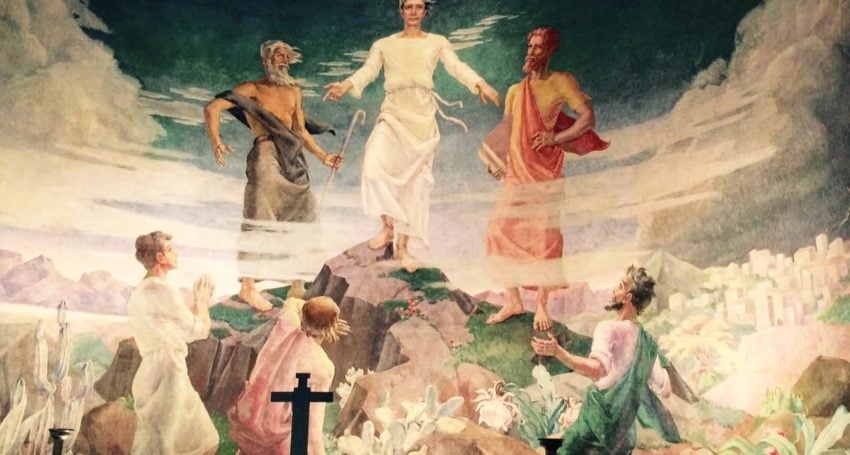The Transfiguration of Our Lord
Features
“This painting is a mural behind the High Altar in the Chapel of the Transfiguration at the College in Colombo, Sri Lanka where my husband Karol was educated and where we have worshipped from time to time. With his choice of subdued colours, the artist, David Paynter intentionally seeks to convey this deeply spiritual experience in the life of Jesus,” says Deanna Misso, as the Transfiguration is celebrated on 6 August

This painting is a mural behind the High Altar in the Chapel of the Transfiguration at the College in Colombo, Sri Lanka where my husband Karol was educated and where we have worshipped from time to time. With his choice of subdued colours, the artist, David Paynter intentionally seeks to convey this deeply spiritual experience in the life of Jesus. The painting speaks to me of the awesome otherness of God. I glimpse what the Gospel writers struggled to put into words. Here I see the God whose glory shines even through clouds of doubt and despair. When gazing at the mural, I am reminded that while the disciples were bewildered and puzzled, they were given a foretaste of God’s purpose for them and their mission in the world.
A Prayer Book for Australia (APBA) observes the Transfiguration as a Feast on 6 August while also providing for its observance as an alternative on the Last Sunday of Epiphany or on the Second Sunday of Lent.
In all three Gospels, the Transfiguration narrative follows Peter’s Confession at Caesarea Philippi (Mark 8.27) and Biblical scholars see it as a turning point in the Gospel narratives: Jesus has made up his mind that Messiahship involved suffering and death.
In Mark 9.2-10, we read the amazing story of how Peter, James and John accompany Jesus to a ‘high mountain’. What happened there is cloaked in mystery. Before the earliest Gospel assumed its present shape, the early Church had surrounded the story with mystery and illusion. We can only try to understand the symbolism of what the disciples saw and experienced.
We know that it was a regular practice of Jesus to go apart by himself to pray (Mark 1.35). Knowing that his death was imminent, he did what he had done throughout his life: sought to commune with the Father. Without claiming too great a certainty about our Lord’s inner life, Jesus as he was praying, underwent a profound spiritual experience in which the disciples were able to enter, alas for a brief time.
Advertisement
The disciples saw him bathed in light, conversing with Moses and Elijah as representatives of the Law and the Prophets. They watched through the haze of sleep-filled eyes as clouds overshadowed the scene and heard a voice saying, “This is my Son, my Chosen, listen to Him”! (Luke 9.35). The three disciples now fully awake were aware that they had been privileged with a vision of our Lord’s glory and presence, and Jesus had the assurance that three of his followers had a glimpse of who he was. However, from this mountain top mystical experience they had to follow him down into the real world.
Like Peter and the other disciples, we, too, are often tempted to linger, to be “lost in love and praise” (Together in Song, # 234) but like them we are called to ministry with head, heart, and hands to “go in peace to love and serve the Lord” (APBA, The Eucharist)
Several years ago when I worked among Vietnamese people seeking asylum in Hong Kong detention camps, I was faced with some of the most challenging situations in my life. Where proselytisation was banned, I had to strive to show God’s love and care for each person in their particular situation. How was I to convince them that the Creator’s will for all was life in all its fullness – in the concrete sheds that gave them shelter – and freedom – behind the six-foot high barbed wire fences that kept them imprisoned?
Advertisement
The United Nations High Commissioner for Refugees, who largely overlooked the camps, arranged for us staff to travel to the mountains of the New Territories annually for a ‘coming apart’ in the quiet beauty of the hills. Here, we were refreshed and renewed, strengthened and transformed to return to face the bitter anger that often erupted among the unhappy, frustrated people who longed for a better life. I learned how actions and behaviour had to be my ‘words’ in order to show them how to tap into inner strength and find courage to make difficult choices, to look towards a future with hope and resilience:
“How good, Lord to be here!
Yet we may not remain;
but since you bid us leave the mount
come with us to the plain.”
(Together in Song, # 234)





